
Running a blog isn’t easy.
According to Orbit Media, it takes more than four hours to write a single blog post, while one in five bloggers spend more than six hours per post:
Say you write a couple of posts a week; that’s at least 32 hours –– or nearly a whole working week –– every month, just spent writing content.
And if you’re one of the more diligent bloggers, that figure shoots up to 48+ hours.
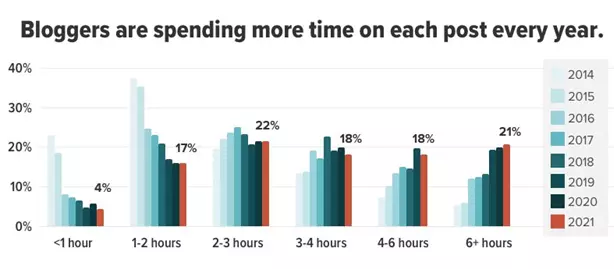
To make matters worse, there’s a good chance blogging is only a tiny part of your job. It might even be a side hustle that you squeeze in alongside a full-time career.
So it’s no wonder plenty of website owners struggle to find time for blogger outreach.
But trust me: you need to make time.
Blogger outreach is one of the most reliable ways to generate backlinks, and pages with lots of backlinks outrank pages with fewer links. On average, the #1 search result in Google has 3.8x more backlinks than positions #2 – #10.
And there are lots of other benefits too. Which is why you’ve made an intelligent choice by clicking on this guide to blogger outreach for beginners, in which I’ll walk you through the blogger outreach process in the simplest possible way.
What is Blogger Outreach?
This blogger outreach guide is pretty in-depth.
I’m going to discuss everything from the various types of blogger outreach that exist to the strategies you need to leverage and the specific steps you need to follow to make it work.
So before we really get into it, I’d better start with a simple definition.
In a nutshell, blogger outreach is about reaching out to and building relationships with influencers and publishers.
I know what you’re thinking: “That sounds awful. Why would I want to spend my time reaching these people voluntarily?”
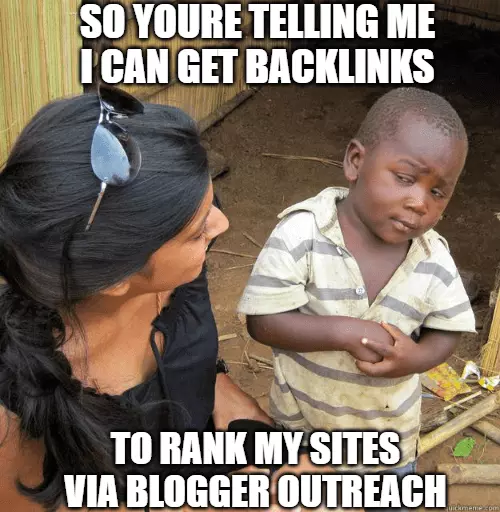
As with any marketing tactic, there’s always a goal behind blogger outreach strategies –– you’re just not doing it for fun.
That goal will vary based on your immediate priorities, but it’ll likely involve one of these:
- Acquiring new backlinks
- Securing guest blogging opportunities
- Raising awareness of your brand or products
- Promoting your existing content
How Exactly Does The Blogger Outreach Work?
Blogger outreach is a lot of work. Acquiring each backlink can feel like climbing Mount Everest when you’re getting started. We have simplified and broken down the entire process into easy simple steps for you to glance over.
- Step #1: Prospect Relevant Bloggers
- Step #2: Pop up On Their Social Radar
- Step #3: Find Email Addresses
- Step #4: Personalize email for bloggers
- Step #5: Set email automation campaign
- Step #6: Follow Up With The Bloggers
Types of Blogger Outreach
Much like a packet of Starburst, there are several different “flavors” of blogger outreach.
And, also like a packet of Starburst, if you pick the wrong “flavor,” you won’t be happy with the results.
Specifically, there are four distinct blogger outreach varieties:
- Link Building: Produced a fantastic piece of content? With blogger outreach, you can use that content to generate valuable backlinks to your site (which, as I’ve already noted, is a key element in improving your SEO). Blogger outreach for link-building purposes means finding bloggers with audiences who’d be interested in the content you’ve created and asking them to link to it.
- Guest Publications: Linking up with bloggers or publishers with the aim of creating some sort of content for them. That way, you can leverage their (hopefully substantial) audience, boost brand awareness, and pick up a valuable backlink. You might even get a bunch of referral traffic to your site too.
- Product Promotion: Typically, this involves connecting with influencers in your niche and asking them to review (and ideally recommend) your product to their audience. Don’t expect this to happen for free; advertorials and reviews are the number one way for bloggers to make money.
- Collaboration: Essentially, this is when brands work with bloggers to create a piece of content –– whether that’s a video, a blog, an infographic, or a series of social posts. Again, this is about raising awareness for the brand (and creating revenue for the blogger).
Blogger Outreach Strategies
When it comes to blogger outreach for beginners, one of the biggest mistakes is to take a one-size-fits-all approach.
In reality, the four outreach strategy types detailed above have very different aims and require different strategies to make them work.
To make matters more confusing, there’s no single, guaranteed-to-work strategy for each type of outreach. Instead, there are multiple viable techniques for each:
Link Building
- Skyscraper Outreach: Just like instant noodles, post-it notes, and the wheel, the skyscraper technique is simple but fiendishly effective: find an existing piece of content with tons of backlinks, create a “better” version, and ask all the folks who linked to the original to link to yours instead.
- Expert Round Outreach: This one works by playing on people’s egos. Reach out to a bunch of industry experts, ask their opinion on something, then use the responses to create a piece of content. Chances are, those experts will link to the results because we humans love being told we’re smart. Also, if they’re “legit” and have big followings, lots of other people will link to it as well.
- Mention Outreach: Mention outreach is the process of reaching out to websites you’ve linked to in your blog posts, and asking them to share, link to, or otherwise promote your content.
- Roundup Outreach: The other side of the mention outreach coin, roundup outreach involves finding sites that publish roundup articles –– like “The 27 Best Blogs About Sheep-Shearing” –– and asking them to include your own sheep-shearing insights in their roundup (alongside a juicy backlink, of course).
- Resources Outreach: Sticking with the sheep-shearing theme for some reason, imagine there’s a site called sheepshearing.org that has a vast pool of resources for sheep-shearing professionals and eager hobbyists. Using the resources outreach technique, you’d ask them to feature your in-depth blog about shearing the Barbados Black Belly.
- Broken Link Building: This sneaky link-building technique involves finding resources in your niche that earned a bunch of backlinks but are no longer live –– maybe the site shut down, or the URL returns a 404 error. You create a new piece of content on the same topic, then ask all the people who linked to the now-defunct original to point their links at your site instead. I like to think it’s how Machiavelli would do outreach.
Guest Publications
- Guest Posting Outreach: This method involves asking bloggers or site owners if they’d let you write a guest post for them (hence the name), often in exchange for a backlink. Everyone uses this approach because it gets fast results when done right. But success is all about the initial pitch. Make it suitably captivating, and you’ll get your post published for free; get it wrong, and you’ll hear nothing but crickets.
- Sponsored Post Outreach: You write a post and pay another site to publish it. Simple. This approach has a high success rate, provided you’re willing to stump up the cash. But whether it actually works is another matter, with 54% of readers saying they don’t trust sponsored content and two-thirds revealing it makes them feel deceived.
Product Promotion
Disclaimer: This whole section is only relevant if you actually have a “product.” That could be a physical product, a SaaS tool, or something else. But if you’re a “pure” blogger and your “product” is the content on your site, this probably isn’t for you.
- Tools Outreach: Also referred to as tools page link building, this approach involves reaching out to websites that have a blog post or resource page full of tools that are similar or relevant to yours and asking them to include your tool.
- Reviews Outreach: Found a site that’s reviewed your competitor’s tool? Ask them to review (and link to) yours as well.
- Versus Outreach: Kind of like reviews outreach, vs. outreach, means finding sites that have written pieces comparing your competitors’ products (e.g., “Jakoti Hand Sheep Shears vs. Burgon & Ball Dagging Shears”) and asking them to write something similar about your product.
Collaboration
Disclaimer: “Collaboration” is a pretty nebulous term. In reality, a “collaboration” between a brand and a blogger, or between two bloggers or two brands, could entail pretty much anything. It might involve something as complex as teaming up to create a whole new product or as simple as agreeing to #FollowFriday one another. As such, this list of strategies is far from exhaustive.
- Link Exchange Outreach: One of the earliest and most abused forms of blogger outreach, link exchanging is what it sounds like: you link to my site, and I’ll link to yours. Google hates excessive link exchanging, so it shouldn’t be your sole link-building tactic. In fact, we recommend avoiding it entirely unless you already have established authority in your niche.
- Social Share Outreach: While most other outreach tactics are geared toward generating backlinks, social share outreach is all about content amplification. It involves reaching out to influencers in your niche with decent social followings and asking them to share your content.
The Battle of Blogger Outreach Approach: Sniper Vs. Shotgun
If you’re keeping count, I’ve mentioned four different outreach styles and a baker’s dozen strategies for making them work.
But wait, there’s more!
Within those 13 different strategies, you can adopt a further two approaches: sniper and shotgun.

You won’t need a firearms license to use them, but you do need to understand what they are and how they work.
Sniper Approach
The sniper lies in wait, biding their time to take the perfect, clean shot with no collateral damage.
Sniper outreach is less fatal but just as effective.
It relies on building a list of quality prospects who are likely to be interested in collaborating with you, stripping out spammy, low-authority sites, and finding a verified email address for each site.
Then, and only then, can you reach out to each site with a personalized message –– not just a generic template.
That process takes a lot of time, but it’s really the only reliable way to get valuable links (or mentions, shares, or whatever your goal is) from high-quality blogs and websites.
Shotgun Approach
If the sniper approach is like performing laser surgery, shotgun outreach is like attempting the same procedure by flailing around with a machete in a crowded room.
Sure, you’re almost guaranteed to hit something, but it’s unlikely to yield the best results for anyone involved.
It’s the opposite of sniper outreach.
Instead of building a qualified list of websites, you simply target as many people as possible. And instead of taking the time to write engaging, personalized emails, you send everyone the same bland message that’s obviously a template.
It’s fast, it lets you do outreach at a vast scale… and it rarely works (at least, not if you want to collaborate with high-authority sites).
Baby Steps To Blogger Outreach
That’s the end of the theory section of our blogger outreach guide. Now let’s take a look at the four practical steps that’ll help you generate real, measurable results from your outreach efforts. I’m talking about:
- Prospecting
- Fine-tuning your prospects
- Reaching out
- Building a relationship
Prospecting
Prospecting is arguably the most important part of the whole outreach process.
If you’re emailing the wrong people, you could create the most ground-breaking content and the most engaging pitch email the world has ever seen, but you still won’t get results.
Fortunately, there are lots of ways to build a decent prospect list, including:
Google SERP Scraping
This is an extremely popular prospecting method because it doesn’t involve any fancy tools and is, theoretically, completely free.
However, it takes a lot of time –– and if your time is more valuably spent elsewhere, it’s not really free at all.
Search engine results page (SERP) scraping starts with a seed keyword relevant to your niche. For our sheep-shearing example, that could be:
- Sheep shearing equipment
- Sheep shearing record
- Chemical sheep shearing
- Sheep shearing course
Pick your seed keyword, then check out the corresponding SERP:
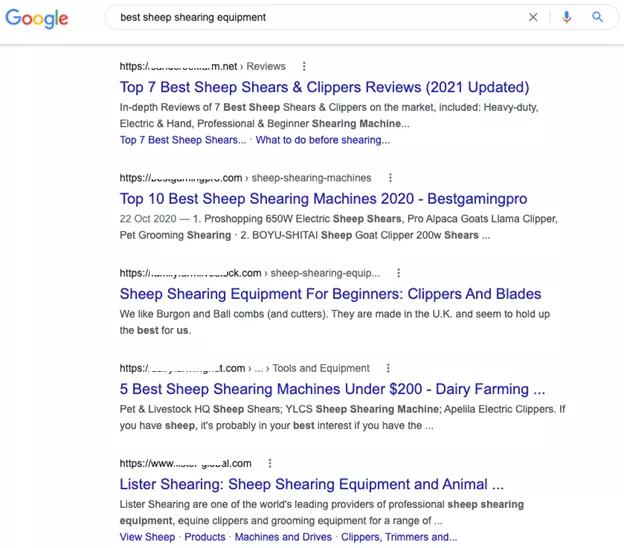
Explore each site, in turn, to see if it writes about topics that are relevant to your business. If they make the grade, add them to your prospecting list.
Directory Scraping
This technique is similar to SERP scraping, except –– as the name suggests –– it revolves around “directories” like LinkedIn, AngelList, and the yellow pages.
Whichever directory you use, the process is essentially the same: search for people and businesses in your niche, then find their domain and add them to your list:
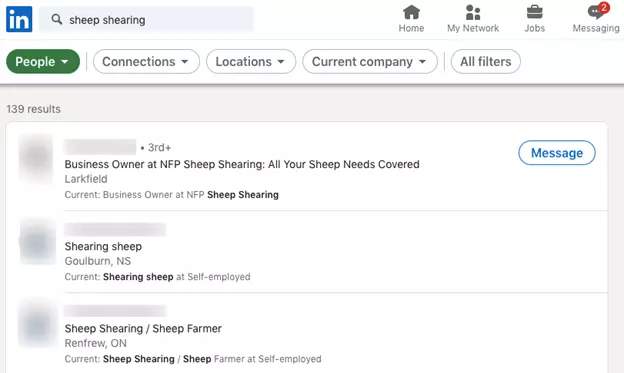
Ahrefs-Based Prospecting
One of the world’s most popular link-building tools, Ahrefs offers a couple of different solutions that work in tandem to help you find likely prospects.
The Ahrefs Content Explorer allows you to access a treasure trove of prospecting information based on a single seed keyword.
As well as providing an exhaustive list of pages that reference your keyword, it shows you the top authors on that topic. You can also filter by language, website platform, and publication date:
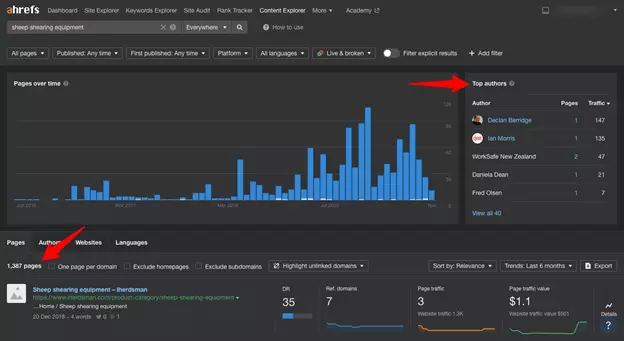
Having gathered a selection of relevant pages, select those that look most relevant and, one by one, plug them into the Site Explorer tool.
That’ll allow you to see all the websites that link to those pieces of content. So theoretically, those sites would be interested in linking to your content as well, right?
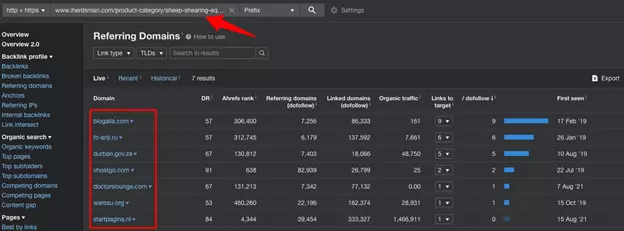
The Simple Alternative: Postaga
If all of those techniques sound like a lot of work, there’s a reason: they are a lot of work.
Mercifully, there’s a pain-free alternative: Postaga.
We’ve created a built-in scraper for prospecting that works like a search engine tailored to specific types of outreach campaigns (e.g., guest posting outreach, tools outreach, etc.).
As well as finding relevant sites that would be good prospects, Postaga filters out results by domain rating if you want to exclude low (or extremely high) authority sites. You can also filter out top-level domains.
For the sites that you choose to reach out to, Postaga automatically finds the right contact. That’ll usually be the author of a specific blog post or someone in a marketing role.
And, as if that wasn’t enough, Postaga will even find and validate their email address for you!
Fine-Tuning Your Prospects
By this point, you should have a bumper list of domains.
Gather them together in a CSV file, then move on to the next stage: fine-tuning.
Since we’re talking about blogger outreach for beginners, it’s important not to get greedy. Far better to focus on a small group of prospects who’ll likely be happy to hear from you and receptive to your proposal.
The following steps will help you build a finely tuned prospect list:
Segmenting
Successful blogger outreach is about striking a balance between shooting for the stars and being realistic.

On one hand, you don’t want a bunch of responses and links from low authority sites.
But on the other, you don’t want to spend all your time chasing super-high-authority sites that just aren’t going to reply.
Segment your prospect list based on each site’s domain authority (DA) or domain rating (DR) –– metrics used by Moz and Ahrefs, respectively, to rate a website’s chances of ranking in SERPs.
Specifically, focus on sites with a DA / DR between 20 and 30. That’s the sweet spot in our experience.
Email Collection
Obviously, if you’re going to reach out to your prospects, you will need an email address.
There are lots of tools for collecting email addresses –– Hunter is one, Rocket Reach is another.
Or Postaga can do it for you in a single dashboard while you’re prospecting –– simple!
Precise Targeting
Not all email addresses are equally valuable.
Sure, [email protected] or [email protected] are legit email addresses, but they’re not the best target for your blogger outreach. They might rarely be monitored, and even if they are, the people monitoring them likely aren’t the people you want to connect with.
Always look for people in charge of a site’s marketing, content, or editing. Or, if it’s a small business or one-person blog, you want to reach the site owner.
Clean Up Your Contacts
Now you’ve got a list of mid-authority domains and corresponding email addresses.
Next, it’s time to verify those email addresses.
Start by weeding out obvious typos like @gmali.com or @yaho.co.
If you want to get advanced, you can use a tool like the MXToolbox DNS Check to assess a domain’s authenticity.
Finally, strip out any email addresses you targeted in previous outreach campaigns –– you don’t want to spam people, after all.
PS: Postaga does that last step automatically.
Launching Your First Campaign
Congratulations, you’ve done all the background work –– now it’s time to roll out your first blogger outreach campaign.
At this point, there are only a few more quick-and-easy steps to follow before that first batch of cold emails wings its way to your prospects’ inboxes:
- Set up an email address, including your signature and profile.
- Connect the email account to your chosen bulk cold email sender.
- Upload your CSV of prospects.
- Write your email copy, tailoring it to the type of campaign you’re running (i.e., make it clear what you’re asking for and what’s in it for them).
- Make it personal, referencing things like the prospect’s name and company. In particular, the opening line needs to be highly personalized.
- Craft an engaging, ultra-clickable subject line. Hint: “Link Request” isn’t going to cut the mustard.
- Add follow-up sequences, without two to four follow-up emails you won’t get enough responses to work with.
Bonus: Blogger Outreach Strategies for New Websites
The whole point of blogger outreach for beginners is that it needs to be simple for everyone.
You can try out more complex, labor-intensive tactics as you scale your approach.
But if you’ve got a new website and need results fast with minimal effort, these tactics are easier to land and take less time:
- Writing guest posts for other sites.
- Take advantage of sponsored posts. If you’ve got the budget, there’s really no limit to the number of sponsored posts you can appear in (although remember, Google doesn’t like paid links very much). Don’t forget to negotiate on price!
- Creating expert roundups. Chances are, your extended network already includes a recognizable expert or two. Reach out to them, get their opinion on a relevant topic, turn it into content, and ask them to share and link to the results.
- Leveraging skyscraper outreach. Creativity is difficult! Let someone else do the hard work by researching heavily linked-to content in your niche and making your own, improved version. If they spoke to 50 experts, you would talk to 100. If they made an infographic, create a new one with up-to-date stats. If they explained the theory behind a certain technique, do the same, but include practical advice too.
FAQs
Yes, blogger outreach works when you do it right. Highly targeted, personalized sniper approach blogger outreach works well.
Yes, you can high-quality sites for blogger outreach. In fact, you should be targeting high-quality sites. At the same time, be realistic. Sites with a DA / DR of 20 – 30 are a good starting point for your outreach efforts.
Blogger outreach in SEO indicates the process of acquiring backlinks from bloggers. More (quality) links mean higher rankings.
Blog outreach can be quite effective when done right. High-quality sniper outreach can be highly effective, helping you collaborate with authoritative sites. But spammy, generic outreach isn’t effective at all.
Yes! always include blogger outreach in your content marketing strategy. Whether the goal of your content marketing strategy is to grow brand awareness, improve your SEO, or generate more leads, blogger outreach will always help.
Yes, it is considered white hat SEO. However, anything that involves exchanging or paying for links falls under grey hat territory and shouldn’t be done excessively.
You should hire people for blogger outreach when you want to scale it or do it for clients. Anyone can do it single-handedly without a team.
Yes, blogger outreach really is worth it. There’s little point in creating content if no one sees it. Blogger outreach amplifies your content and generates the backlinks you need to improve rankings.
Blogger outreach works by forming relationships with influencers and publishers, with the ultimate aim of persuading them to share, publish, or link to your content.
The best tool for blogger outreach is Postaga. Call us biased, but it’s definitely Postaga! If you want an all-in-one tool while balancing cost, productivity level, and simplicity, we genuinely believe it’s the best option.
Free 14-Day Trial
Start building relationships now with your fully-featured 14-day trial!
How We Compare
Terms | Done-For-You Terms | Privacy | Write For Us | Press
© 2025 Postaga. All Rights Reserved. Made with 
